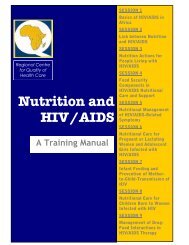2.1: Anthropometric Indicators Measurement Guide - Linkages Project
2.1: Anthropometric Indicators Measurement Guide - Linkages Project
2.1: Anthropometric Indicators Measurement Guide - Linkages Project
Create successful ePaper yourself
Turn your PDF publications into a flip-book with our unique Google optimized e-Paper software.
9.<br />
• Do not restrict your sample to families<br />
living in easily accessible households,<br />
such as those close to a main road or near<br />
a village center; families living in less<br />
accessible areas may be poorer and less<br />
healthy.<br />
• Do not omit households where no one<br />
is at home the first time you call.<br />
Sampling error can also happen if the<br />
sample size is not large enough.<br />
Sample Size<br />
Factors influencing sample size decisions<br />
The sample size required for a given<br />
survey is determined by its measurement<br />
objectives. For surveys designed to either<br />
measure changes in indicators over time<br />
or differences in indicators between<br />
project and control areas, the required<br />
sample size for a given indicator for each<br />
survey round and/or comparison group<br />
depends upon five factors:<br />
• how numerous the measurement units<br />
for the indicator are in the target<br />
population;<br />
• the initial or “baseline” level of the<br />
indicator;<br />
• the magnitude of change or<br />
comparison group differences on the<br />
indicator it is desired to be able to reliably<br />
measure;<br />
• the degree of confidence with which it<br />
is desired to be certain that an observed<br />
change or comparison-group difference of<br />
the magnitude specified above would not<br />
have occurred by chance (that is, the level<br />
of statistical significance); and<br />
• the degree of confidence with which it<br />
is desired to be certain of measuring an<br />
actual change or difference of the<br />
magnitude specified above will be<br />
detected (i.e., statistical power).<br />
Note that the first two of these parameters<br />
are population characteristics, while the<br />
last three are chosen by the evaluator/<br />
survey designer.<br />
An example using changes in<br />
nutritional status:<br />
To illustrate how these parameters enter<br />
into the determination of sample size<br />
requirements, consider an evaluation<br />
where changes in indicators for the<br />
project area are being measured over time<br />
(i.e., a one-group pretest-post-test or<br />
reflexive design). For such an evaluation,<br />
the objectives for sample size<br />
determination purposes might be stated in<br />
terms of a key indicator as follows: to be<br />
able to measure a decrease of 20<br />
percentage points in the proportion of<br />
children 6-59 months of age who are<br />
stunted with 95% confidence and 80%<br />
power. Thus, if the estimated proportion<br />
of children who were stunted at the time<br />
of the baseline survey was 40%, the<br />
objective would be to measure a change in<br />
the prevalence of stunted children from<br />
40% to 20% and be (1) 95% confident that<br />
a decline of this magnitude would not<br />
have occurred by chance and (2) 80%<br />
confident of detecting such a decline if one<br />
actually occurred. The sample size<br />
calculations would answer the questions<br />
(1) how many children ages 6-59 months<br />
would be required to accomplish the<br />
above objectives and (2) how many<br />
households would have to be chosen in<br />
order to find this number of children.<br />
For evaluation designs involving comparisons<br />
between project and control<br />
areas, the objectives are framed in terms<br />
of the magnitude of differences between<br />
the two groups it is desired to be able to<br />
reliably detect. For example, in a reflexive<br />
evaluation design, sample size requirements<br />
might be set to detect a difference<br />
between project and control areas of 20<br />
percentage points on a specified indicator.<br />
Similarly, when a pre- and post-test<br />
design with treatment and control areas is<br />
to be used, the sample size would be set to<br />
ensure that a difference in the degree of<br />
change on a key indicator between project<br />
and control areas of a specified magnitude<br />
(e.g., 20 percentage points) could be<br />
reliably detected.<br />
70

















